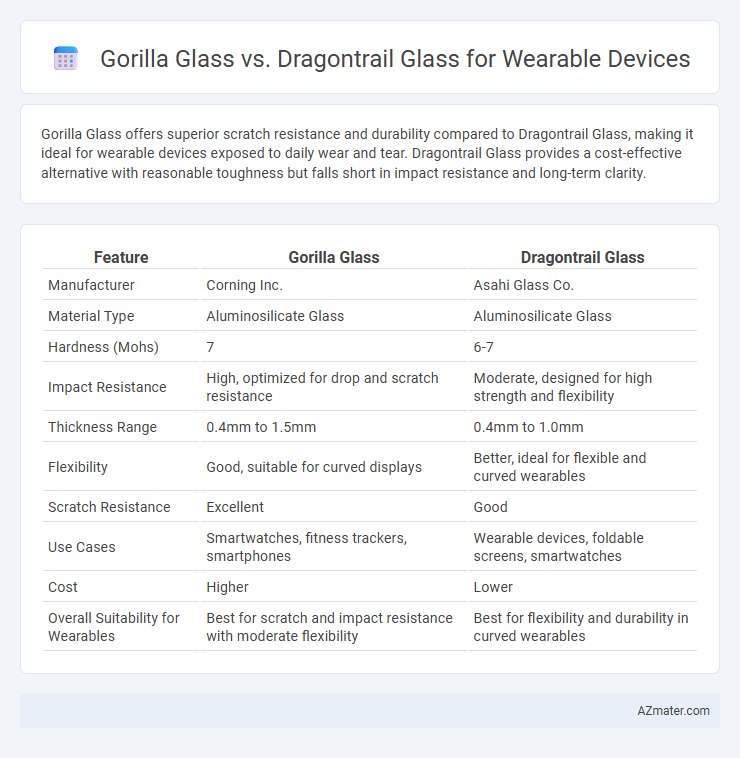Gorilla Glass offers superior scratch resistance and durability compared to Dragontrail Glass, making it ideal for wearable devices exposed to daily wear and tear. Dragontrail Glass provides a cost-effective alternative with reasonable toughness but falls short in impact resistance and long-term clarity.
Table of Comparison
| Feature | Gorilla Glass | Dragontrail Glass |
|---|---|---|
| Manufacturer | Corning Inc. | Asahi Glass Co. |
| Material Type | Aluminosilicate Glass | Aluminosilicate Glass |
| Hardness (Mohs) | 7 | 6-7 |
| Impact Resistance | High, optimized for drop and scratch resistance | Moderate, designed for high strength and flexibility |
| Thickness Range | 0.4mm to 1.5mm | 0.4mm to 1.0mm |
| Flexibility | Good, suitable for curved displays | Better, ideal for flexible and curved wearables |
| Scratch Resistance | Excellent | Good |
| Use Cases | Smartwatches, fitness trackers, smartphones | Wearable devices, foldable screens, smartwatches |
| Cost | Higher | Lower |
| Overall Suitability for Wearables | Best for scratch and impact resistance with moderate flexibility | Best for flexibility and durability in curved wearables |
Introduction: Gorilla Glass vs Dragontrail Glass for Wearables
Gorilla Glass and Dragontrail Glass are two leading chemically strengthened glass technologies commonly used in wearable devices for enhanced durability and scratch resistance. Gorilla Glass, developed by Corning, offers superior toughness and impact resistance due to its aluminosilicate composition, making it ideal for rugged wearables. Dragontrail Glass, produced by Asahi Glass Co., provides competitive hardness and flexibility through its alkali-aluminosilicate formulation, often favored for slimmer wearable designs where lightweight and thin profiles are essential.
Material Composition and Manufacturing Process
Gorilla Glass is an alkali-aluminosilicate glass known for its high chemical strengthening through ion-exchange processes, enhancing scratch and impact resistance, making it ideal for wearable devices. Dragontrail glass, composed of alkali-aluminosilicate with a toughened chemical treatment, undergoes a similar ion-exchange process but emphasizes higher flexibility and durability against bending stresses. Both materials are manufactured using precise thermal and chemical treatments, but Gorilla Glass typically benefits from a more advanced ion-exchange depth, offering slightly superior toughness for the dynamic wearables market.
Scratch Resistance: Which Glass Holds Up Better?
Gorilla Glass offers superior scratch resistance for wearable devices due to its chemically strengthened aluminosilicate composition, providing enhanced durability against everyday abrasions and impacts. Dragontrail glass, made from alkali-aluminosilicate, also delivers good scratch resistance but generally falls short compared to Gorilla Glass in hardness and longevity. Studies show Gorilla Glass maintains better surface integrity under repeated contact with abrasive materials, making it the preferred choice for rugged wearable screens.
Impact Durability and Drop Protection
Gorilla Glass offers superior impact durability for wearable devices due to its chemically strengthened composition, providing higher resistance to scratches and shattering during drops. Dragontrail glass, while also chemically strengthened, generally exhibits slightly less resistance to impact but maintains excellent flexibility and damage tolerance under bending stress. Devices equipped with Gorilla Glass typically deliver enhanced drop protection, reducing the likelihood of screen fractures in everyday wear scenarios.
Optical Clarity and Touch Sensitivity in Wearables
Gorilla Glass features superior optical clarity with high light transmittance up to 92%, ensuring vibrant and sharp displays ideal for wearable devices. Dragontrail Glass offers good touch sensitivity with smooth surface responsiveness, although it may exhibit slightly lower light transmission, affecting screen brightness. For wearables demanding crisp visuals and precise touch input, Gorilla Glass remains the preferred choice due to its advanced aluminosilicate composition and ultra-thin design.
Thickness and Weight Considerations
Gorilla Glass typically offers thinner and lighter layers compared to Dragontrail glass, enhancing the sleekness of wearable devices without compromising durability. The reduced thickness of Gorilla Glass contributes to lower overall weight, which is crucial for comfort in wearable technology. Dragontrail glass, while slightly thicker, provides robust protection but may add marginally more weight, influencing the ergonomic design of wearable gadgets.
Cost Comparison: Budget Implications for Wearable Devices
Gorilla Glass typically incurs higher manufacturing costs due to its chemically strengthened aluminosilicate composition, leading to elevated prices for wearable devices targeting premium markets. Dragontrail Glass offers a more cost-effective alternative with comparable durability and scratch resistance, making it an attractive choice for budget-conscious manufacturers of wearable technology. Selecting Dragontrail can reduce overall production expenses, allowing brands to maintain quality while delivering more affordable wearable devices to consumers.
Compatibility with Curved and Flexible Displays
Gorilla Glass offers exceptional compatibility with curved and flexible displays due to its advanced chemically strengthened composition, which maintains durability while allowing for thin, flexible designs in wearable devices. Dragontrail glass also supports curved surfaces but tends to be less flexible than Gorilla Glass, making it better suited for slightly curved rather than highly flexible or foldable wearables. Manufacturers often prefer Gorilla Glass for cutting-edge wearables that require high scratch resistance combined with excellent adaptability to complex screen shapes.
Market Adoption: Popular Wearables Using Gorilla or Dragontrail
Gorilla Glass dominates the wearable device market with widespread adoption by major brands like Apple Watch, Fitbit, and Samsung Galaxy Watch, due to its superior scratch resistance and durability. Dragontrail glass, favored by brands such as Xiaomi and Huawei, offers a competitive alternative with cost-effective strength suitable for mid-range wearables. Market trends indicate Gorilla Glass maintains a larger share in premium devices, while Dragontrail gains traction in budget-friendly wearables seeking reliable screen protection.
Conclusion: Which Glass Is Best for Your Wearable Device?
Gorilla Glass offers superior scratch resistance and toughness, making it ideal for wearable devices subjected to frequent impacts and rough use. Dragontrail Glass provides a balanced combination of strength and flexibility, often at a more affordable cost, suitable for budget-conscious wearables that still require durability. Selecting between the two depends on whether the primary priorities are maximum toughness and premium protection (Gorilla Glass) or cost-efficiency with reliable durability (Dragontrail Glass).

Infographic: Gorilla glass vs Dragontrail glass for Wearable device
 azmater.com
azmater.com